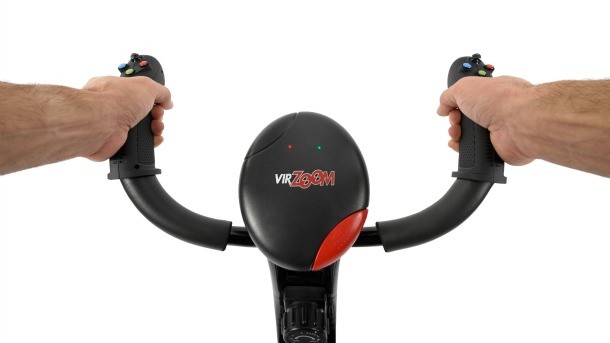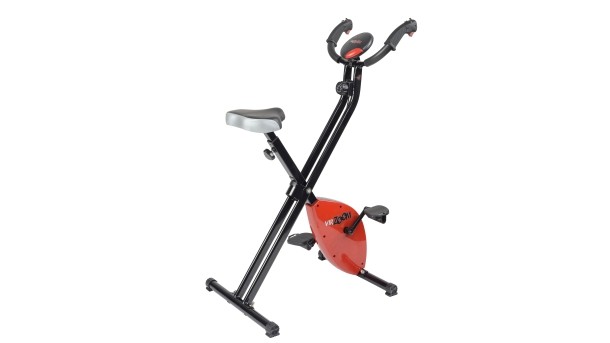Taking VirZoom, The VR Exercise Bike, For A Longer Spin

Last December, I got a quick look at VirZoom, an exercise bike that doubles as a game controller for virtual reality headsets. I was fairly positive on the equipment and concept, but questioned its ease of use without a trained person around to get you set up, and how long the experience could remain motivating for the average individual. I received a VirZoom pre-release unit in the office and took it for an extended spin. Now, with many miles behind me, I have a clearer picture of what the product offers.
Assembling the VirZoom took little effort, just some time. Using a screwdriver and an Allen wrench, the assembly is fairly self-explanatory and as long as you have your VR headset already up and running you should be ready to kick off your exercise before long. Once the bike was assembled, I plugged the USB dongle into the PC, threw some batteries into the electronic component of the VirZoom controller, and installed the software.
The bike is sturdy and folds up for compact storage, but is pretty heavy for some people to move by themselves. While you’re using the controller, the pedals are whisper quiet even when you’re in pushing hard. If you want to ratchet up the challenge of your workout and gameplay, you can adjust the pedal tension using a dial similar to what is found on a standard stationary bike.

The bike feels sturdy when you’re seated upright, but some small issues began to present themselves once I started shifting around more. One issue I ran into was when sprinted in the standing position. As my weight shifted, the bike folded slightly and gave me a feeling of instability.
When using the bike as a game controller, you lean your weight to left or right to turn your in-game character. During some sequences, the combination of leaning far to one side to make sharp turns and being in the virtual world made me feel unstable. I was never sure if it was the bike actually feeling unstable, or if it was just my body knowing that it was leaning but the visual representation not reflecting it beyond the character turning.
The bike controller accomplishes its mission of diverting your attention away from the fact that you’re exercising through giving you in-game objectives. From a concept as simple as pedaling to power a racecar around a track to a game that gives you different missions as you ride a Pegasus through a canyon, VirZoom does a good job of keeping the experiences diverse and interesting. These are far from sprawling triple-A adventures; VirZoom instead leans toward the minigame-style of gameplay. The alpha build of the software I used had seven games in various stages of development: Stampede, Go Fast Car, Tank, Pegaso, Apache, Motorcycle, and Dragonfly.

Stampede places you on a horse as you race down the main road of a town in the Wild West. Bandits flee on horseback, and it’s your job to catch up to them by pedaling harder, then lasso them by pressing a button on the handle and timing your throw to match up with a circular meter. A successful throw pulls the bandit off his horse and gets you one step closer to completing the wave. Stampede sticks out as the game that’s best at diverting your attention away from the fact that you’re exercising with its nonstop, fast-paced action and timing-based gameplay.
Go Fast Car puts you in the driver seat of a high-speed automobile as you do laps around a track. You can choose to race against live opponents, A.I. rivals, or yourself. While you must be strategic in what gear you’re in, Go Fast Car felt the most like a standard workout, as the strong mental correlation of running around a track doesn’t quite let your brain forget that you’re exercising.
With Tank, you’re in control of a powerful war machine as you hunt down opposing forces across a large map. A few hits knock you out of the game, but luckily the A.I. enemies don’t have the best aim. I enjoyed aiming with my head gestures, then pressing one of the controller’s buttons to fire. It wasn’t necessarily the fastest-paced game, but I had fun hunting down the A.I. enemies and blasting them to bits.

One game that I enjoyed during my guided demo late last year was Pegaso, which places you on the back of a winged horse in a massive canyon. A few different experiences give you unique takes on the same formula, from simple riding along a winding trail in a time trial to flying around the canyon picking up items to stay alive. This game is the one that I got most competitive with as I pushed myself to stay airborne, even when my muscles started tiring.
Apache marries the concepts of Tank and Pegaso to deliver perhaps my favorite game in this alpha build. Flying a chopper equipped with missiles down a river, you must collect fuel barrels to stay in the air while aiming at enemy targets with head gestures and firing using the buttons. With so much going on, the sweat running down my face was the only thing keeping the fact that I was exercising in the front of my mind.
The alpha build I played contained two games that are obviously very early in development, as there is no structure or scoring system yet in place for either of them. The build of Motorcycle dropped me in an open area where I could ride around. The area had some minor obstacles I could tackle, like a row of school buses with ramps on either side, or some moguls to ride over. With the VirZoom controller featuring the form of a standard stationary bike, riding a motorcycle in VR felt natural right off the bat.

Dragonfly puts you in the role of the titular insect as you fly through hoops in a wooded environment. Again, this game wasn’t very far along in development at the stage I tried it, so it’s hard to judge how the final product will turn out, but I’m definitely interested.
VirZoom is a novel concept that has an uphill battle in front of it. The virtual reality landscape that exists today is far from the point of maturation, and manufacturing issues are affecting the size of the installed user base of each headset at this early stage. It could be difficult for VirZoom to carve out a significant player base out of the demographic that not only owns a virtual reality headset, but also wants to use it to exercise. Added to the list of issues is the cost of entry when you factor in the already-high price of owning a headset and a VR-ready PC. VirZoom is also scheduled to work with PlayStation VR and GearVR, so there are lower cost ways to take advantage of it.
Perhaps the biggest obstacle VirZoom faces is in convincing players that it’s okay to sweat into their $400-or-more VR headset. The components that touch your face aren’t rubber – they’re more of a spongy material – meaning that the headsets aren’t easily wiped down when it comes to sweat. I often felt guilty using our office Vive headset for VirZoom since it’s shared with others. Unless VirZoom has some way to alleviate this issue, it’s bound to turn off some people.

The VirZoom VR bike controller accomplishes its primary objective of providing fun distractions to motivate people to get their daily workouts in. While the team at VirZoom undoubtedly has some obstacles to overcome with regards to making this a viable product, it is a cool idea. I enjoyed my time with the games available in the build I played, and I could see myself enjoying it on a regular basis – given that I could figure out a way to sweat-proof my VR headset.
The impressions in this piece were formed using the VirZoom controller with the HTC Vive virtual reality headset.

Get the Game Informer Print Edition!
Explore your favorite games in premium print format, delivered to your door.
- 10 issues per year
- Only $4.80 per issue
- Full digital magazine archive access
- Since 1991









